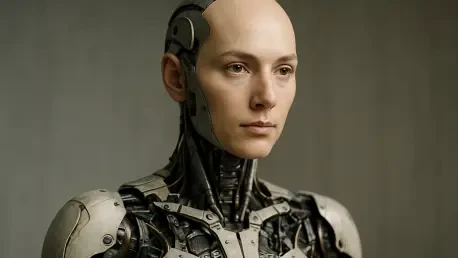Imagine a robot so lifelike that spectators question whether it’s a machine or a human disguised in a metallic shell, sparking debates and doubts across tech circles, and leaving many in awe of its uncanny realism. At a recent AI Day event in Guangzhou, Xpeng, a prominent Chinese electric vehicle manufacturer, unveiled its Next-Gen Iron humanoid robot, a creation so strikingly realistic that it stirred skepticism among even the most seasoned tech enthusiasts. The startling realism of this robot prompted an unprecedented response from the company, leading to a dramatic public demonstration to prove its mechanical nature. This moment not only captivated the audience but also highlighted a growing intersection of advanced technology and public perception, where innovation must sometimes be dissected—literally—to gain trust. As humanoid robotics advance at a rapid pace, Xpeng’s bold move raises critical questions about the boundaries between artificial and human, setting the stage for a deeper exploration of this groundbreaking development in AI and engineering.
Unveiling a Technological Marvel
The introduction of Next-Gen Iron at Xpeng’s AI Day was nothing short of a spectacle, designed to showcase the pinnacle of humanoid robotics. This robot, a significant upgrade from its predecessor, features a humanoid spine, bionic muscles, and flexible skin that mimic human anatomy with uncanny precision. With 82 degrees of freedom throughout its body and 22 in its intricately designed hands, equipped with the industry’s smallest harmonic joint, the robot moves with a fluidity rarely seen in machines. Powered by all-solid-state batteries and Xpeng’s second-generation VLA (Vision-Language-Action) model, supported by three Turing AI chips delivering 2,250 TOPS of computing power, Next-Gen Iron can walk, converse, and interact with humans and other robots in ways that blur the line between artificial and organic. This technological leap has positioned Xpeng at the forefront of robotics, drawing attention to how far the field has come in creating machines that emulate human behavior, challenging preconceived notions of what robots can achieve.
Public reaction to Next-Gen Iron was a mix of awe and disbelief, with many questioning the authenticity of its lifelike presentation. Skepticism spread rapidly, as online discussions and live attendees speculated whether this was truly a robot or an elaborate hoax involving a human in a suit. To address these doubts head-on, Xpeng’s CEO, He Xiaopeng, and his team made a daring decision just 24 hours after the debut. In a dramatic on-stage act, they cut open the robot’s leg, revealing its mechanical internals to a stunned audience. Described as a last-resort measure, this bold step underscored the company’s commitment to transparency while highlighting the challenges of introducing technology that appears almost too real. He’s lighthearted remark about the sleepless night endured by the robotics team added a human touch to the intense moment, emphasizing the lengths to which Xpeng went to validate their innovation in the face of widespread doubt.
Future Horizons for Humanoid Robotics
Looking ahead, Xpeng envisions a transformative role for Next-Gen Iron in various sectors, with plans to integrate these robots into commercial and public service environments by next year. Potential applications include roles such as tour guides and sales clerks, where their ability to interact naturally with humans could redefine customer experiences. The company has ambitious goals for large-scale mass production by the end of 2026, signaling a shift toward widespread adoption of humanoid robots in everyday settings. Additionally, hints at customizable body shapes suggest a future where these machines could be tailored for specific needs or aesthetics, though timelines for household use remain undisclosed. This vision paints a picture of a society where robots are not just tools but active participants in daily life, prompting discussions on how such technology might reshape industries like tourism and retail while raising ethical considerations about human-robot dynamics.
The broader implications of Next-Gen Iron extend beyond practical applications, touching on cultural and imaginative realms. Parallels to science fiction, such as the HBO series “Westworld,” come to mind, where lifelike robots populate interactive theme parks, blending fantasy with reality. Xpeng’s advancements could inspire similar concepts in China, merging entertainment with cutting-edge technology. Furthermore, recognition from industry leaders, as reported in Chinese media, underscores the competitive landscape of humanoid robotics, with companies like Xpeng emerging as key players alongside global giants. CEO He Xiaopeng’s social media response to such acknowledgment reflected national pride, framing the robot as a symbol of technological achievement. This blend of innovation and cultural resonance highlights how Next-Gen Iron is not just a product but a catalyst for envisioning a future where the boundaries between human and machine continue to blur, challenging societal norms and expectations.
Reflecting on a Defining Moment
Looking back, the unveiling of Next-Gen Iron marked a pivotal chapter in the evolution of humanoid robotics, where Xpeng’s creation captivated and confounded audiences with its lifelike precision. The drastic measure of cutting open the robot to dispel doubts stood as a testament to the company’s resolve to bridge the gap between skepticism and trust, leaving an indelible impression on all who witnessed it. This event not only showcased remarkable engineering but also sparked vital conversations about the nature of artificial beings in modern society. As the dust settled, the focus shifted to actionable next steps, such as refining public understanding of these technologies through transparent demonstrations and education. Xpeng’s commitment to rolling out such robots for commercial use in the near future suggests a proactive approach to integration, urging industries and policymakers to prepare for a world where human-robot interactions are routine. This defining moment serves as a reminder that embracing such advancements requires balancing marvel with mindfulness, ensuring that society is ready for the realities of a robotic age.









